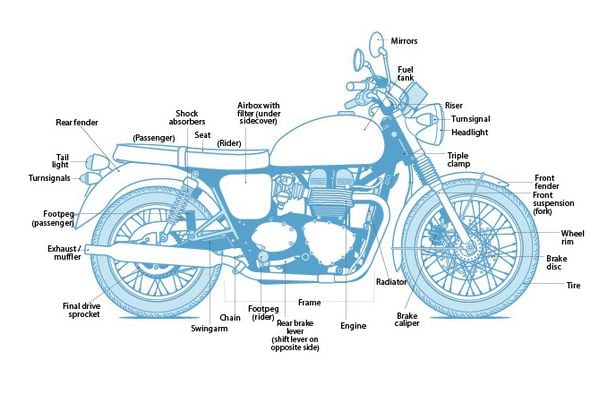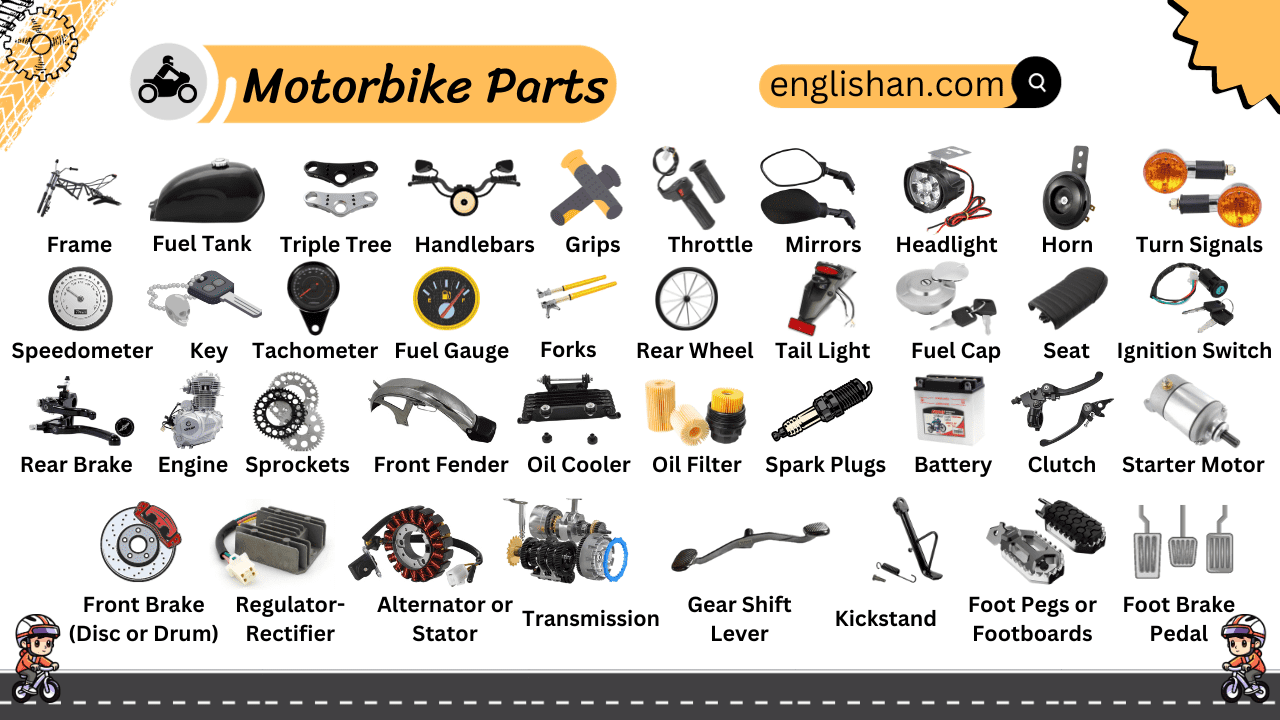The Top Maintenance Habits to Extend the Life of Your Motorcycle Spares Christchurch
A Comprehensive Guide to Selecting the Finest Bike Components for Your Adventure
Selecting the right bike parts is vital for any type of bicyclist. Each part plays a considerable role in enhancing performance and comfort. Comprehending the kind of bike and its intended usage is basic. From handlebars to tires, every information matters. This guide will discover the important facets of selecting these parts. The appropriate selections can boost any kind of adventure, yet what details variables should one take into consideration to attain the very best outcomes?
Comprehending Bike Types and Their Components
How can one pick the appropriate bike components without comprehending the different sorts of bicycles? Each bike kind-- mountain, hybrid, cruiser, and roadway-- attributes special elements tailored to its details function. Mountain bicycle, for circumstances, are furnished with robust frames and bigger tires for off-road stability, while road bikes focus on lightweight products and aerodynamic designs for rate on paved surfaces.Hybrids mix aspects from both hill and road bikes, offering convenience for different terrains. Cruisers, created for comfort, attribute larger seats and handlebars for a more kicked back riding position. Each kind also makes use of distinct equipment systems, brakes, and wheels that deal with their designated use.Understanding these differences is essential for choosing suitable and effective bike components. A biker's choice can especially boost performance, safety, and overall enjoyment. By identifying the qualities of each bike kind, one can make enlightened decisions when updating or changing parts.
Trick Considerations for Finding Handlebars
When choosing handlebars, a rider needs to consider various variables that can greatly affect comfort and control. One key factor to consider is the width of the handlebars, as it influences stability and take advantage of throughout trips. Wider handlebars normally supply better control, especially in technological surfaces, while narrower ones may enhance aerodynamics for racing.Additionally, the increase or decline of the handlebars affects the biker's pose. Greater handlebars promote a much more upright placement, minimizing stress on the back, while lower ones can improve aerodynamics. The form of the handlebars is additionally essential; alternatives like flat, riser, or decrease bars accommodate different riding styles and preferences.Material is an additional vital factor, with light weight aluminum and carbon fiber being preferred for their equilibrium of weight and sturdiness. Inevitably, the appropriate handlebars need to straighten with the motorcyclist's intended use, making sure a reliable and enjoyable cycling experience.
Picking the Right Saddle for Convenience and Efficiency
Picking the appropriate saddle is crucial for optimizing convenience and efficiency during experiences. A well-chosen saddle can substantially affect a bicyclist's experience, directly affecting power levels and total satisfaction. When picking a saddle, aspects such as shape, size, and padding ought to be very carefully thought about. The saddle's width must align with the rider's rest bone measurements, ensuring appropriate support. Additionally, extra padding preferences differ amongst cyclists; some may favor marginal padding for a much more direct connection to the bike, while others might seek luxurious cushioning for improved convenience on longer adventures. Saddle shape additionally plays a crucial role, as it impacts the distribution of pressure throughout pedaling. Materials utilized in building and construction can impact weight and resilience. Inevitably, evaluating various saddles is essential, as personal comfort differs greatly. A thoughtful technique to saddle choice can lead to better efficiency and an extra pleasurable biking experience.
The Significance of Quality Tires for Various Surfaces
Selecting the right tires is essential for suitable efficiency across various surfaces. Different surfaces demand certain tire attributes, such as tread patterns and rubber compounds, to ensure grip and durability. Additionally, the long life and resilience of tires can noticeably affect a biker's overall experience and safety and security on the road or path.

Terrain-Specific Tire Includes
Just how does the terrain impact tire performance? Various terrains require distinct tire functions to enhance efficiency and safety and security. Hill cycling on rough tracks needs tires with hostile walk patterns to offer hold and stability. On the other hand, roadway biking on smooth surfaces gain from narrower tires that reduce rolling resistance.In wet or muddy conditions, tires designed with much deeper grooves can channel water effectively, avoiding hydroplaning. Additionally, softer compounds might boost grip on glossy surfaces, while harder compounds supply durability on harsh courses. Comprehending these terrain-specific tire functions is important for cyclists intending to boost their riding experience. Choosing the suitable tire not only influences taking care of yet likewise overall convenience, making it crucial for cyclists to match their tires to their designated terrain.
Tire Durability and Efficiency
Quality tires considerably influence a biker's efficiency and safety throughout different terrains. The durability of tires is crucial for standing up to the rigors of various surfaces, from sturdy tracks to smooth roads. Greater quality tires frequently include strengthened sidewalls and advanced rubber compounds, which improve their longevity and grasp. Tires designed for off-road conditions typically possess much deeper treads that supply better traction on loosened surfaces, while road tires focus on a smoother account for decreased rolling resistance. In damp problems, tires with specialized walk patterns can boost handling and reduce the risk of hydroplaning. Inevitably, investing in high quality tires customized to specific riding atmospheres can considerably improve general biking experience, ensuring both performance and safety.
Gearing Systems: Discovering the Perfect Fit for Your Riding Style
While lots of bikers understand the value of an excellent bike frame or wheels, the gearing system plays a necessary duty in enhancing performance and comfort when driving or route. Picking the right gearing system depends mainly on private riding design and surface. Road bicyclists typically profit from a small gearing configuration, enabling for smoother shifts and higher speeds on flat surfaces. On the other hand, hill bikers might favor a bigger variety of gears to tackle steep climbs up and harsh descents.Cyclists need to likewise think about the number of gears; a 1x system streamlines changing and lowers weight, while a 2x or 3x system uses adaptability for different terrains. Understanding equipment proportions is crucial, as lower ratios facilitate less complicated pedaling uphill, while greater ratios support rate on level stretches. Eventually, the perfect gearing system harmonizes with the biker's preferences, guaranteeing a enjoyable this post and efficient biking experience.
Enhancing Your Adventure With the Right Brakes
Picking the appropriate stopping system is as crucial as choosing the right tailoring for a bike. The top quality and sort of brakes can significantly influence a biker's control, safety, and total riding experience. Bicyclists frequently face an option between edge brakes and disc brakes. Rim brakes are commonly lighter and much easier to maintain, making them a popular alternative for road bikes, while disc brakes offer exceptional quiting power and efficiency in varied weather, perfect for mountain bikes and touring setups.Moreover, brake pads play a necessary function in stopping efficiency. Picking the best product-- such as natural, metallic, or semi-metallic-- can boost performance based on riding conditions and individual choices. Furthermore, correct alignment and routine upkeep of the braking system assurance reliable performance and long life. Inevitably, buying the appropriate brakes tailored to private riding designs can boost safety and pleasure on every adventure.
Updating Accessories for a Better Cycling Experience
Updating devices can substantially enhance a bicyclist's experience when driving. Essential security gear, such as lights and headgears, incorporated with comfort enhancements like ergonomic holds and cushioned seats, can make a significant distinction. These upgrades not just boost safety and security but also promote longer and much more satisfying adventures.
Crucial Safety Gear
Safety equipment is an essential component of a cyclist's arsenal, enhancing both protection and comfort when driving. Helmets are one of the most essential thing, substantially lowering the threat of head injuries in case of an accident. High-visibility clothes and accessories, such as reflective vests and lights, guarantee that bikers continue to be visible to drivers, especially in low-light conditions. Gloves provide grasp and lower the chance of sores, while knee and arm joint pads can provide added protection during drops. Selecting suitable footwear with an excellent hold can likewise enhance safety and security while cycling. Buying top quality safety and security gear not only advertises a much safer ride yet likewise boosts a biker's self-confidence, enabling them to appreciate their cycling experience to the greatest.
Convenience Enhancements and Upgrades
Cyclists often look for to enhance their riding experience past fundamental safety procedures. Comfort improvements and upgrades play a vital role in attaining this goal. Among the most substantial upgrades is a top notch saddle, developed to give maximum assistance and decrease pain throughout longer trips. On top of that, handlebar grips that use better comfort designs can reduce pressure on hands and wrists. Purchasing cushioned cycling shorts can furthermore enhance comfort by decreasing friction and pressure factors. Shock-absorbing seat blog posts and broader tires can enhance trip top quality by dampening resonances from rough surface. Adjusting the bike fit warranties that settings are perfect for private cyclists, leading to a more pleasurable and comfortable cycling experience.
Frequently Asked Questions
How Do I Maintain My Bike Parts for Longevity?
Maintaining bike parts for longevity entails normal cleansing, lubrication, and examination. Correct storage space far from wetness, timely substitute of worn parts, and adherence to maker guidelines can greatly improve the lifespan and efficiency of the Continued bicycle.
What Tools Do I Required for Bike Component Setup?
To set up bike parts properly, one typically calls for necessary tools such as wrenches, screwdrivers, tire bars, a multi-tool, and a pump. These instruments facilitate correct assembly, making certain suitable performance and long life of the bicycle parts.
How Usually Should I Replace Bike Parts?

Can I Mix and Match Components From Different Brands?
Matching and blending bike parts from various brands is possible, but compatibility is crucial (Bike Parts Wellington). Factors like dimensions, materials, and layout must be considered to assure peak performance and safety and security, highlighting the value of research before any kind of combination
What Are the Indications of Damaged Bike Parts?
Indications of damaged bike parts include uncommon sounds during experiences, lowered performance, visible damages such as splits or rust, and problem changing equipments. Regular assessments can aid identify these issues before they endanger safety and security and performance. Mountain bikes, for instance, are furnished with durable structures and larger tires for off-road stability, while road bikes focus on light-weight products and wind resistant designs for speed on paved surfaces.Hybrids blend aspects from both hill and roadway bikes, offering flexibility for different surfaces. Alternatively, roadway biking on smooth surface areas advantages from narrower tires that minimize rolling resistance.In muddy or wet conditions, tires developed with deeper grooves can transport water properly, protecting against hydroplaning. Understanding these terrain-specific tire features is important for bicyclists aiming to enhance their riding experience. Tires More Help developed for off-road conditions usually possess deeper treads that offer far better grip on loosened surface areas, while road tires prioritize a smoother profile for decreased rolling resistance. To mount bike components successfully, one commonly calls for necessary devices such as wrenches, screwdrivers, tire levers, a multi-tool, and a pump.